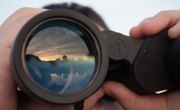
Lenses exist in a variety of places around us, from the interior of the human eye to the inner workings of computer memory systems. Positive, or "converging," lenses focus light to a specific focal point, a process which has applications ranging from improving vision to transmitting light information. Knowing some everyday applications of converging lenses helps illustrate their function and use.
Magnifying Glasses
The magnifying glass represents one of the simplest, most direct applications of a converging lens. As light enters the lens, it becomes focused to a specific focal point in front of the center of the lens. Once you bring the magnifying glass to the optimal distance, so the focal point reaches the object, the object will appear at maximum magnification. Move the glass farther from the object and it will become distorted; move the glass closer to the object and it will decrease in magnification.
Eyeglasses
A person becomes nearsighted or farsighted because the lens of the eye fails to properly focus light on the retina. In the case of farsightedness, the lens of the eye focuses the image too far behind the retina. This causes difficulty in focusing on objects close to the eye. A converging lens placed in front of the eye bends the incoming light sharply so the focal point shortens and the light focuses properly on the retina.
Cameras
Cameras utilize converging lenses not only to focus an image but also to magnify it. Most camera lenses consist of a converging lens followed by an diverging lens followed by a second converging lens. The first lens controls the magnification level of the image by moving toward or away from the object. Light passes through the first lens and through the diverging lens, which flips the inverted image. The final converging lens then inverts the image one last time and delivers the image to the rear of the camera. The image then prints on the film or digital media surface.
Microscopes
Microscopes utilize converging lenses to create extremely magnified images of small objects. Most simple microscopes consist of three lenses. The first lens at the end of the microscope produces a magnified and inverted image. The second lens inverts and magnifies this image, while the final lens (the eyepiece) delivers the magnified, upright image of the object viewed in front of the first lens. By changing the distance of the first lens from the object, the image delivered to the eyepiece will appear more or less magnified.
References
Photo Credits
Jupiterimages/Photos.com/Getty Images
